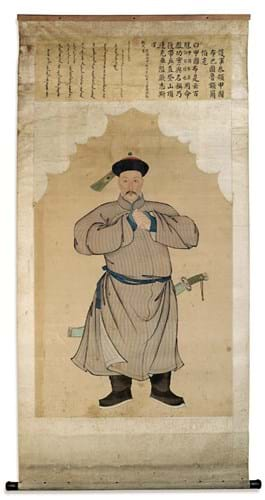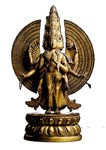
£1 = €1.2
ASIAN art sales are traditionally among the last specialist auctions of the year to be staged in Germany.
One of these took place at Lempertz (24% buyer’s premium) in Cologne on December 8-9.
Bidding was consistent and, as was to be expected, Chinese buyers carried away numerous lots, many making use of a special Chineselanguage website that the auction house had set up for online bidding.
Top honours went to a 15in (38cm) high gilt bronze figure of Buddha Shakyamuni, which once belonged to the German publisher and collector Alexander Koch. He was responsible for the most influential journals about late 19th and early 20th century design and works of art. The Ming period figure was catalogued at €30,000-40,000, but finally changed hands for €70,000 (£58,335).
The 17th-18th century Sino- Tibetan or Mongolian figure of Maitreya in a European seating posture previewed in ATG No 2270 went just over the lower estimate to sell for €51,000 (£42,500).
Among the other top lots was a 17th or 18th century rhinoceros horn libation cup, carved with a rocky landscape of strolling scholars, a fishing boat by the shore and stylised waves. The 5in (13cm) high vessel was knocked down for a midestimate €60,000 (£50,000).
Papyrus secret revealed
Meanwhile, in another part of town, Van Ham (28% buyer’s premium) also held its sale of Asian art on December 8. Here too Chinese bidders were a driving force, one of their prizes being a 8½in (21cm) high, 15th century bronze of the Green Târâ, the mother of the Buddha of past, present and future.
A particular attraction of the well-preserved Tibetan figure was revealed by a radiological examination before the sale that showed the presence of strips of papyrus and some rice corns, sealed into the hollow base. The experts are convinced that the base has never been opened.
All of this contributed to a hammer price of €48,000 (£40,000), which was four times the lower estimate.
There was a spectacular re-evaluation of another Chinese work of art, a 16in (42cm) high, copper and brass censer with residues of gilding and black patina. It was finely pierced and decorated with lotus scrolls and the character for long life (shou), with dragons forming the feet and the handle.
It bore a Xuande mark, which would have dated it to the 15th century. Van Ham’s experts saw it as a piece from the Qing dynasty (1644- 1911) and estimated it accordingly at €2300-2800. Nevertheless, 10 phone bidders joined the action and as a result the price was driven to €75,000 (£62,500), with a Chinese private collector emerging victorious.
In Stuttgart, Nagel (33% buyer’s premium) closed its autumn season with a two-day sale of Asian art on December 9-10. The firm’s presence at the Asian Art in London week paid dividends, with several new customers contributing to the turnover.
Plenty of surprises and numerous six-figure prices emerged, although there were also disappointments.
The enthusiasm for pieces of Chinese furniture from the Bork Collection was somewhat muted and several of the top pieces failed to find buyers, including the 18th century canopy bed with pierced and carved aprons (previewed in ATG No 2270), which was expected to bring €50,000-80,000.
On the other hand, the firegilt bronze figure of the 11-faced Ekadashalokeshvara, the work of a Tibetan or Chinese craftsman of the Qianlong Period (1711-99), was driven from the estimate of €50,000- 80,000 to €280,000 (£233,335). It went to a Hong Kong collector against mainland Chinese competition.
Scroll paintings on silk attracted a lot of interest, among them one dated 1516 and painted in the style of Chou Ying, a famous 16th century master, with a landscape of mountains and houses.
It was knocked down to a Canadian collector of Chinese origin for €150,000 (£125,000), three times the lower estimate.
An ever bigger price surge greeted a late 18th century portrait of the regimental commander of the palace guards, painted by a court artist in 1776 with an inscription singing the praises of the courageous commander.
The portrait was one of a hundred commissioned by the Qianlong Emperor to honour officers who had excelled themselves in the military campaign to suppress the hill people of the province of Jinchuan, now part of Sichuan.
The wall hangings were displayed in the Hall of Purple Splendour in the Imperial Palace. During the Boxer Rebellion of 1900 the hall was plundered and the hangings dispersed. Around this time a German collector bought this particular painting, which had remained in the family ever since.
Nagel’s estimate of €20,000- 30,000 was too tempting for Chinese bidders to ignore a piece of their imperial heritage. They forced the price up to €400,000 (£333,335), which was the highest of the sale, with the hammer falling to a Hong Kong collector.








